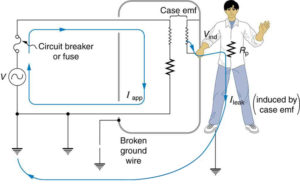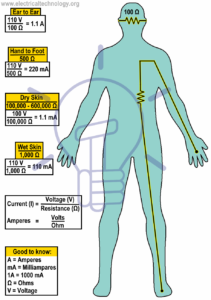AC vs DC Electric Shock: Which is More Dangerous? Electric shocks can vary in intensity depending on the type of current—AC or DC—and several other factors. While some believe that DC current delivers a stronger shock because it is constant, studies reveal that alternating current (AC) can be far more hazardous.
AC vs DC Electric Shock: Which is More Dangerous?
Many of us believe that the intensity of the shock from AC and DC voltage of the same value will be the same. Some also think that a DC current shock will be felt more intensely compared to an AC current. The reason for this belief is that AC current, due to its frequency, can disconnect more easily, but this is not possible with DC.
However, the real fact is that the shock from AC current is felt more intensely and is more deadly, and this is because of the frequency. Let’s explore the reason behind this.
An electric shock is a sensation caused when current flows through a part of our body. The intensity of this shock depends on several factors, such as the type of current (DC/AC), frequency, voltage level, the part of the body it passes through, and the duration of the flow. The sensation of a 50/60Hz AC shock is five times greater than that of a DC shock.

Moreover, the sensation of a 50/60Hz AC shock is six times greater than that of a 5000Hz AC current, and the feeling of shock decreases as the frequency increases.
The reason is that our brain sends low-frequency electric signals through nerve cells to move our muscles. Similarly, the human heart beats at a frequency of 60-100 bpm (beats per minute), which is controlled by electric signals from the brain. Therefore, a 50-60Hz current shock is felt more intensely because it directly interferes with the nervous system’s signaling!
As a result, with a certain amount of current flow, you will lose control over your muscles.
In such cases, even if you want to, you won’t be able to free yourself from the electrified object. Additionally, if a certain amount of 50-60Hz current flows through your heart, it will disrupt its regular rhythm, resulting in cardiac arrest and death.
Hence, always be cautious of 50-60Hz AC current. Another reason AC is more dangerous than DC of the same voltage is that the human skin acts like a capacitance to the ground. Due to this property, AC current can flow easily from the skin to the ground, while DC current encounters more resistance.
The chart below shows that the same amount of AC current is more dangerous. For a 150-pound person, 62mA DC current is required for a painful shock, whereas only 9mA of AC current is enough. If the frequency is 10KHz, it would be 55mA.

99% of the total resistance in the human body is in the skin. The dry resistance of the human body is about 100,000 ohms, whereas the internal resistance is only 300 ohms. If current flows through the body due to a skin wound, the amount will be significant, and the shock will be dangerous. High voltage AC and DC both cause skin breakdown, allowing more current to flow through the body, which is hazardous.
You also already know that AC voltage/current is measured in RMS, while DC is measured in peak or maximum value.

We know that V(peak) = 1.4142 * V(rms).
Thus, if a person gets a shock from 220V DC, they will be shocked at 220V. But if a person gets a shock from 220V AC, they will experience a shock of up to 1.4142 * 220V = 311V. And 311V is definitely higher than 220V. So, it can be said that AC is more dangerous than DC.
AC vs DC: Which is more dangerous?
AC (Alternating Current) is generally considered more dangerous than DC (Direct Current) at the same voltage levels. This is primarily due to AC’s ability to disrupt the body’s nervous system and heart rhythm because of its frequency. AC’s alternating nature makes it harder for muscles to release from the current, increasing the risk of prolonged exposure and cardiac arrest.
230V DC vs 230V AC: Which is more dangerous?
230V AC is more dangerous than 230V DC. Although both can be harmful, AC at 230V can deliver a peak voltage of around 325V (due to the RMS-to-peak conversion factor), making it more hazardous. Additionally, the alternating frequency of AC increases the likelihood of interference with the heart’s rhythm and muscle contractions.
What is the full meaning of AC and DC?
AC stands for “Alternating Current,” which means the flow of electric charge periodically reverses direction. DC stands for “Direct Current,” meaning the flow of electric charge is unidirectional, maintaining a constant direction throughout its flow.
Is DC safer than AC?
In general, DC (Direct Current) is considered less dangerous than AC (Alternating Current) at the same voltage level. AC’s alternating nature (due to its frequency) is more likely to interfere with the human body’s nervous system, especially the heart, making it more hazardous. However, high-voltage DC can still be extremely dangerous and cause severe injury or death.
How many volts of DC is dangerous?
DC voltages above 50V are considered dangerous. While lower DC voltages can still cause harm, particularly in sensitive situations like wet conditions, voltages of 50V or higher pose significant risks of electric shock, burns, or even fatal injury, depending on the current and exposure duration.


